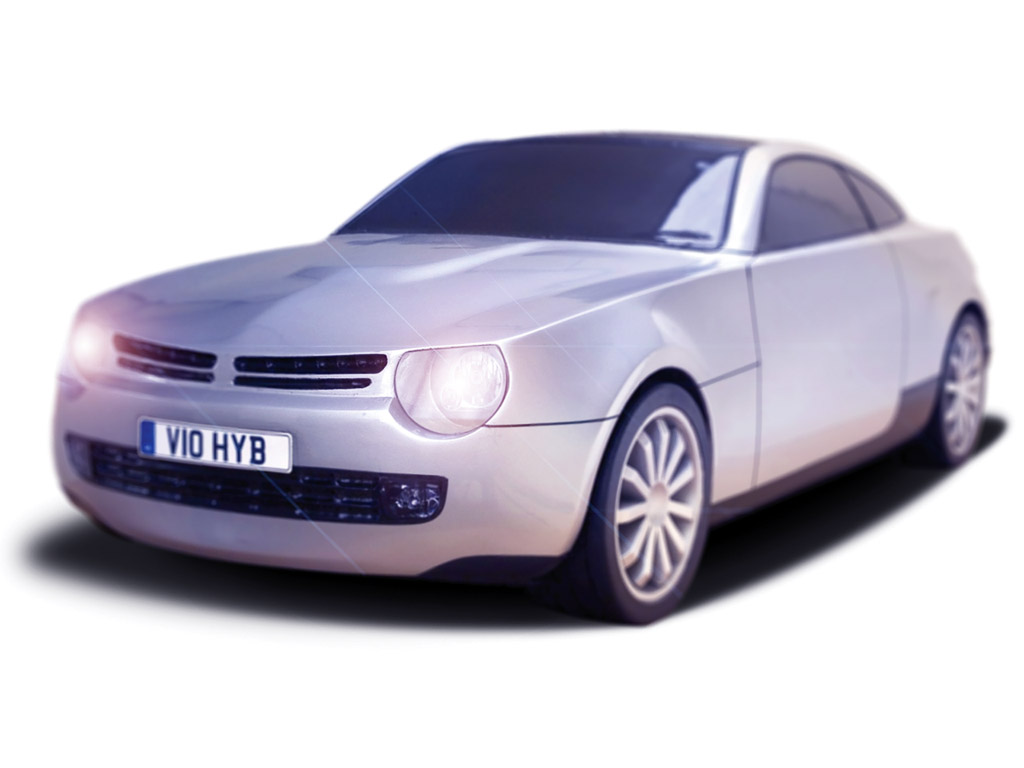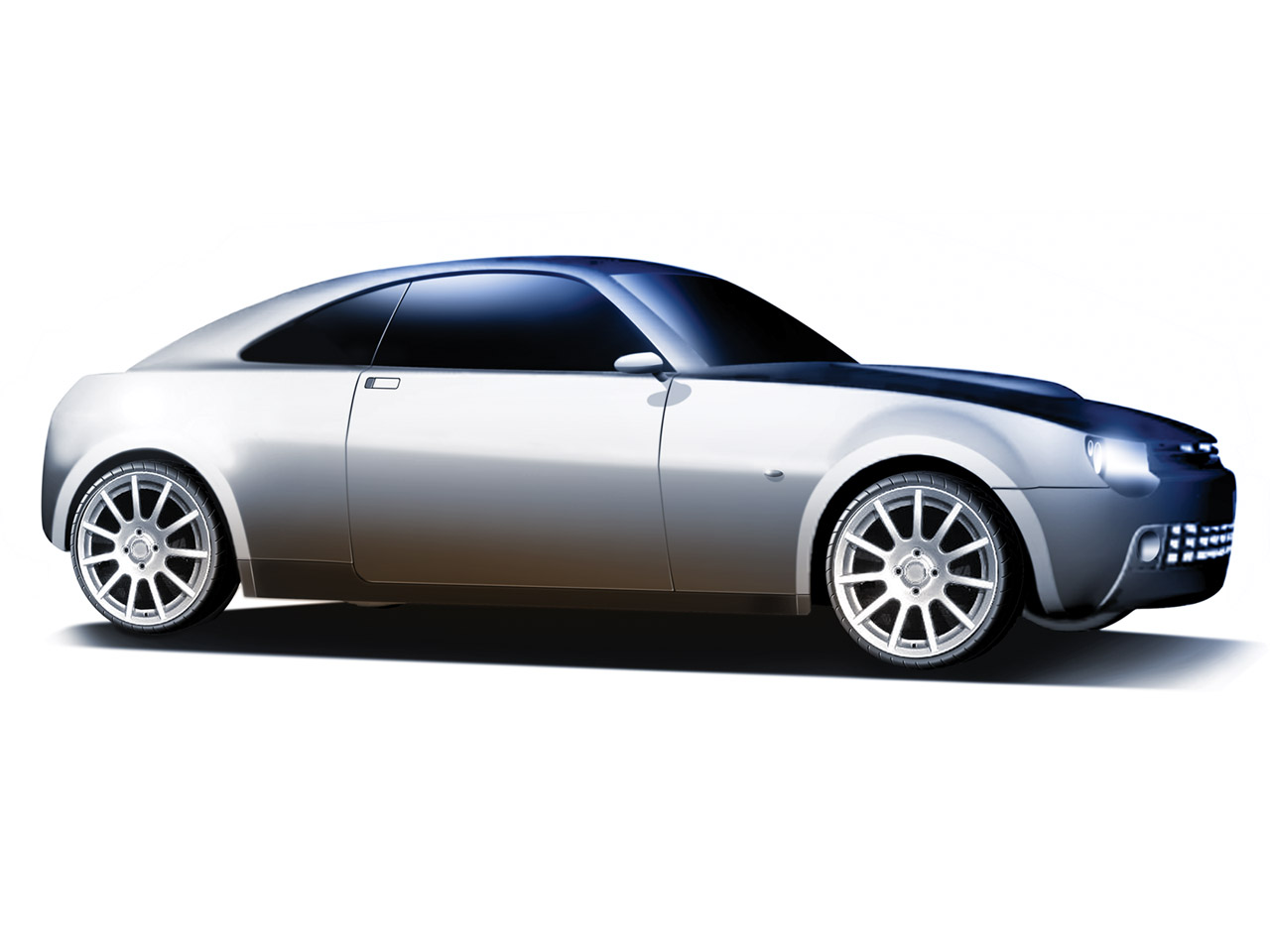Type-D
|
Price |
£35,000 (approx $62,000 US) |
Weight |
1653 lbs | ||
|
Engine |
2110 cc V10 hybrid |
Transmission |
-- | ||
|
Aspiration |
-- |
Torque |
144 lb-ft @ 1000-6000 rpm | ||
|
HP |
162 hp @ 6000 rpm |
HP/Weight |
10.2 lbs per hp | ||
|
HP/Liter |
77 hp per liter |
1/4 mile |
-- | ||
|
0-60 mph |
6.2 seconds |
Top Speed |
140 mph |
(from Connaught Press
Release) A revolutionary concept in vehicle design and
engineering was announced this morning (3 September) when the
Connaught Motor Company revealed its first project – the Type-D
sports coupé – at the Goodwood Revival meeting.
Featuring the first ever V10 hybrid engine, Connaught's Type-D beats
mainstream manufacturers in the race to produce a high performance
energy-efficient sports car. The stunning coupé will deliver 140mph,
0-60mph in 6.2s, 42mpg and genuine 2+2+ seating configuration, while
still complying with ultra-low emissions targets set for 2010.
The brainchild of two ex-Jaguar consultant engineers, Tim Bishop and
Tony Martindale, the Connaught Type-D has to date received almost
half a million pounds worth of funding from the Energy Saving Trust
and has no less than 17 patents pending on its ground-breaking
technology.
The car was previewed at Goodwood's Revival meeting, a fitting venue
to resurrect a famous name of 1950s automotive engineering, but the
new Connaught Motor Company is no heritage-laden throw-back to past
eras.
Connaught is the first virtual car company. It designs the car and
manages the project, but out-sources the manufacturing to
Derby-based partners EPM Technology, thereby ensuring relatively low
start-up investment costs.
The ultra-lightweight construction helps to realise the ambitious
fuel efficiency targets while the mid-front north-south mounted
engine and rear-wheel drive configuration guarantees maximum driving
pleasure without compromising rear space. The cleverly engineered
convertible ‘Eclipse’ version will have electrically-powered
stacking glass panels which disappear into the boot lid without loss
of luggage space. The Type-D will be competitively priced starting
at around £35,000.
"Our aim has been to build a car for the future while keeping the
design and technology relatively simple," explains Tim Bishop,
vehicle engineering director, "and to establish close links with our
technology partners EPM Technology for the assembly and Coventry
University on the styling side. We have met all our own development
targets and are confident to gain five-star EuroNCAP crash test
results and maximum score for pedestrian safety."
Powertrain: a study in energy efficiency
Connaught plays down the
Type-D's hybrid drive, wishing to distance its sports coupé from
existing hybrid cars with their utilitarian aura and earnest
greenness. Market research has revealed that some potential buyers
of pleasure machines are put off by the hybrid idea, thanks to
inaccurate preconceptions of plugging the cars into the mains and
thoughts of slow electric vehicles. Buyers with some technical
understanding are more likely to appreciate the benefits, however,
and in the longer term the Connaught will be seen as a pioneer in
its field.
So for 'hybrid', read Connaught's alternative description:
HigherBred. Think of the electric motor as a torque-assist system, a
means to an end rather than an end in itself. First, though, the
heart of the Type-D.
V10 power
The all-aluminium,
ultra-compact, 2110cc V10 engine is packed with innovative features.
The vee-angle is just 22.5 degrees, which makes the engine narrow
and gives good balance with even firing intervals. The wet cylinder
liners mate directly with the cylinder head, with no gasket, and
other components are sealed with rubber where necessary.
The crankshaft is pressed together from 22 components, and fed into
the block from one end. Its webs double as very large main-bearing
journals, but the bearing surface is very slender to keep friction
down. The pistons have ceramic crowns, to reduce the heat transfer
to the block that would otherwise be the V10 configuration's biggest
snag given a cylinder surface-to-volume ratio much higher than that
of, say, a four-cylinder engine. Future developments could include
V8 and V12 versions of the engine.
For a rapid warm-up and maximum efficiency, the cylinder head has
its own water-cooling circuit. When the block needs to be cooled as
well, an interconnecting valve opens to unite the cooling circuits,
pumped by an electric water pump as required. There are two valves
per cylinder, a single overhead camshaft per bank with bucket
tappets and variable valve timing system, and a very high (13.5 to
one) compression ratio. Cross-linking of opposite inlet ports
produces pressure pulses to improve low-speed torque, and each
cylinder has its own throttle valve.
The engine alone reaches its torque peak at 4000rpm, but with the
electric motor assisting its efforts there's a flat torque curve of
144lb ft from 1000rpm right up to 6000rpm. That strong low-end pull
is the secret of the Connaught's pace, delivering a pulling ability
extraordinary for such a compact engine unit. Maximum combined power
– 162bhp – arrives at 6000rpm.
Added electricity
The Lynch electric motor
is attached to the crankshaft nose, via a variable gearing system
designed to exploit the fact that an electric motor delivers its
highest torque at its lowest speeds. The drive system ensures that
the motor always runs at the best speed for the conditions. It's
powered by, and recharges, a 48-volt electrical supply, which keeps
current levels low and makes for quicker recharging. There's also a
capacitive and fast charging storage system to respond instantly to
big current demands, for example to help with sudden acceleration.
When the Type-D is stationary, the petrol engine does not run. The
air-conditioning can still operate if needed, though, thanks to that
48-volt electrical system. To move off, you press the clutch pedal
down, select a gear, press the accelerator and the engine fires up
as you engage the clutch and move away. There's none of the usual
chatter and jerk of a conventional starter, because the electric
motor performs the job of starting the engine.
Three modes alter how the electric motor is used. Sport mode uses
all available motor assistance, but will use up the battery power so
it cannot be engaged all the time. Normal mode adds battery charging
on deceleration (regenerative braking) and rations the motor
assistance. Economy mode maximises the deceleration charge. Pressing
the sport button also opens valves in the intake and exhaust systems
for a sportier sound – 'like a Formula One car at half speed,' says
Tim Bishop.
Heated catalysts
One problem with turning
an engine on and off is that the catalytic converters cool down,
making for excess emissions when restarting. To overcome this, the
Type-D has heated catalysts powered by the 48-volt electrical system
that also handles the hybrid drive. They need an excess of air just
after start-up to make them 'light off' again. This is neatly
achieved by cutting the fuel supply to two cylinders for a few
revolutions, so they act as an air pump.
Thus equipped, the Connaught Type-D should meet Euro 4 emissions,
could qualify as an ultra-low emissions vehicle in the US were it to
be sold there (for which there are no current plans), and should
have average CO2 emissions of 150g/km.
British-built gearbox
The five-speed gearbox, made by Mitchell Cotts which also supplies gearboxes to Caterham Cars, uses proprietary internals in a specially designed casing. A six-speed sequential transmission is a possible future option.
Structure and suspension
A target weight of just
750kg without fluids (for the base model) doesn't have to mean
carbonfibre panels or exotic, hard-to-repair, bonded aluminium
chassis sections. The Type-D's chassis is built up mainly from
laser-cut, flat steel and tubular sections, many of them with
numerous large holes to save weight. It's designed to collapse
progressively on impact, to be repaired easily and cheaply
afterwards and to last well thanks to hot-dip galvanising.
Extensive computer simulation points to a five-star EuroNCAP crash
test result, and Connaught plans to put the Type-D through the real
test once it's in production.
The completed structure, with its Twintex inner tub and aluminium
superstructure, has a torsional stiffness of around 7400lb ft/degree
(10,000NM/degree). Its bonded-on Twintex polypropylene/glassfibre
tub contributes to this figure, and the material has other
advantages: recyclable, no resin smell, and good sound absorption.
The aluminium body panels will be hand-formed at first, then pressed
on soft tooling as production builds up.
Wishbones all round
Tim Bishop wanted the
Connaught Type-D to have ride and handling much like that of the
original Lotus Elan. Light weight, relatively soft springing and
tight damping control are the keys here, and the Type-D has some
intriguing componentry.
All the wishbones are aluminium castings, but while the upper ones
are conventional the lower ones – all four of which are machined
from identical castings – are anything but. They are large, wide and
hinge on an axis at right-angles to the car's centre line. So the
front ones are leading links, the rear ones trailing links. This
reduces dive under braking and squat under acceleration, reduces
geometry change as the wheels move in their generous suspension
travel, and enables loads to be fed into the strongest part of the
structure. The wide-based pivots allow the use of soft suspension
bushes, too, which gives a smoother, quieter ride.
One effect of the geometry is that the roll centre rises as the car
leans, so the inner rear wheel can still handle lots of drive
torque. This means the Connaught doesn't need a limited-slip
differential, although it will be an option along with traction
control and an electronic stability system. There are no anti-roll
bars, and the Connaught's light weight should render power steering
unnecessary despite optional wide 35-profile tyres.
The spare wheel lies horizontally between the front wishbones, and
forms an integral part of the crash structure.



